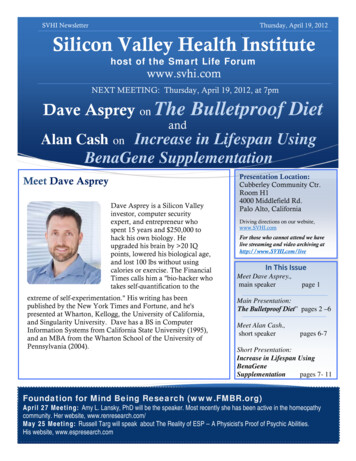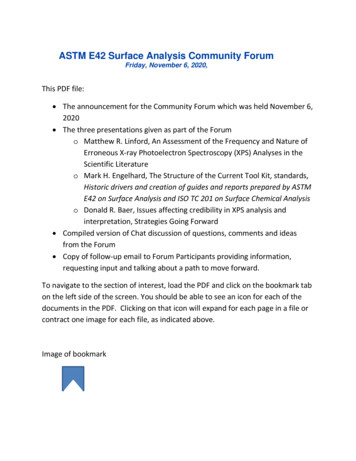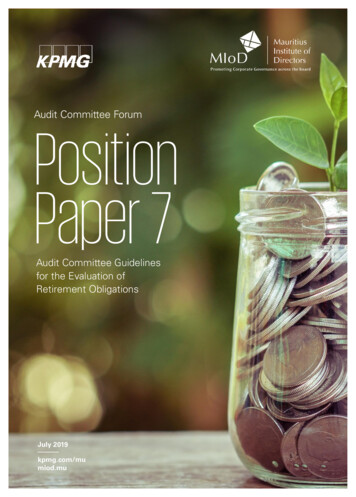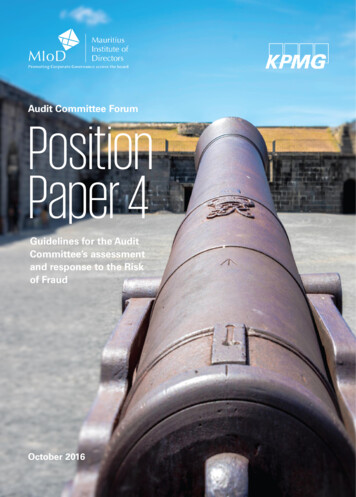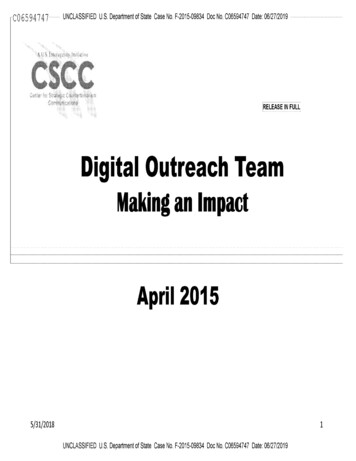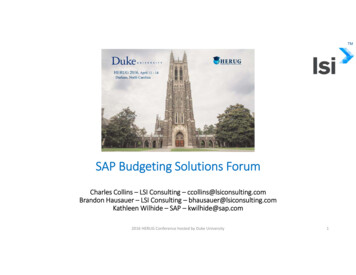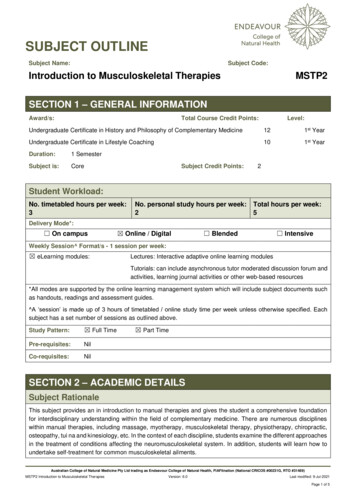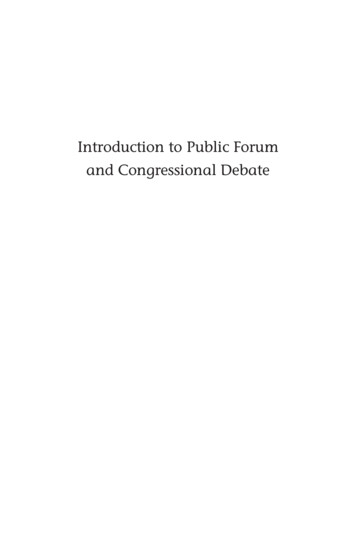
Transcription
Introduction to Public Forumand Congressional Debate
Introduction to Public Forumand Congressional DebateJeffrey HannanBenjamin BerkmanChad MeadowsInternational Debate Education AssociationNew York, London & Amsterdam
Published by:International Debate Education Association105 East 22nd StreetNew York, NY 10010Copyright 2012 by International Debate Education AssociationThis work is licensed under the Creative Commons AttributionLicense: ibrary of Congress Cataloging-in-Publication DataHannan, Jeffrey.Introduction to public forum and Congressional debate / Jeffrey Hannan, Benjamin Berkman, Chad Meadows.p. cm.ISBN 978-1-61770-038-51. Debates and debating. I. Berkman, Benjamin. II. Meadows,Chad. III. Title.PN4181.H263 2012808.5’3--dc232012027912Design by Kathleen HayesPrinted in the USA
AcknowledgementsWe would like to thank the National Forensic League andthe International Debate Education Association for theirtireless advocacy and support for forensics around theworld. Adam Jacobi and Cherian Koshy of the NFL havemade invaluable contributions, and we are especially grateful for their support.Eleanora von Dehsen has been a wonderful resource asan editor, and without her impressive dedication this volume would only be a shadow of its current self.All the authors thank the countless coaches and colleagues who have provided professional and personalsupport, particularly Lisa Miller of Nova High School.Chad thanks his lovely girlfriend, Myra Milam, for hersupport; Jeff thanks his loving and patient wife, Adie.
ContentsAcknowledgements . . . . . . . . . . . . . . . . . . . . . . . . . . . . .vPreface . . . . . . . . . . . . . . . . . . . . . . . . . . . . . . . . . . . . . .xiiiChapter 1: Overview of Public Forum Debate . . . . . . .1The Resolution . . . . . . . . . . . . . . . . . . . . . . . . . . .2Sides . . . . . . . . . . . . . . . . . . . . . . . . . . . . . . . . . .3Speeches . . . . . . . . . . . . . . . . . . . . . . . . . . . . . . .4Constructive Speeches . . . . . . . . . . . . . . . . . .5Crossfire . . . . . . . . . . . . . . . . . . . . . . . . . . . . .6Rebuttal Speeches . . . . . . . . . . . . . . . . . . . . . .6Summary Speeches . . . . . . . . . . . . . . . . . . . . .7Grand Crossfire . . . . . . . . . . . . . . . . . . . . . . . .7Final Focus . . . . . . . . . . . . . . . . . . . . . . . . . . .7Preparation Time . . . . . . . . . . . . . . . . . . . . . . . . .7Determining the Winner . . . . . . . . . . . . . . . . . . .8Rounds . . . . . . . . . . . . . . . . . . . . . . . . . . . . . . . . .8Chapter 2: Overview of Congressional Debate . . . . . .11Preparation . . . . . . . . . . . . . . . . . . . . . . . . . . . . .12The Session . . . . . . . . . . . . . . . . . . . . . . . . . . . . .12Electing the Presiding Officer and Setting theAgenda . . . . . . . . . . . . . . . . . . . . . . . . . . . . . . . . .13Debate . . . . . . . . . . . . . . . . . . . . . . . . . . . . . . . . .13Speaking, Precedence, and Recency . . . . . . . . . . .15
Ending the Session. . . . . . . . . . . . . . . . . . . . . . .17Judges . . . . . . . . . . . . . . . . . . . . . . . . . . . . . . . . .17Chapter 3: Argument Construction . . . . . . . . . . . . . . .19Elements of an Argument . . . . . . . . . . . . . . . . . . .19Claims . . . . . . . . . . . . . . . . . . . . . . . . . . . . . .21Warrants . . . . . . . . . . . . . . . . . . . . . . . . . . . . .23Data . . . . . . . . . . . . . . . . . . . . . . . . . . . . . . . .25Impacts . . . . . . . . . . . . . . . . . . . . . . . . . . . . . .26Filling in the Gaps . . . . . . . . . . . . . . . . . . . . . . . .27Chapter 4: Congressional Debate Legislation . . . . . . .31Types of Legislation . . . . . . . . . . . . . . . . . . . . . . .31Bills .viii. . . . . . . . . . . . . . . . . . . . . . . . . . . . . . .33Resolutions . . . . . . . . . . . . . . . . . . . . . . . . . . .33Constitutional Amendments . . . . . . . . . . . . . .34Structure of a Bill . . . . . . . . . . . . . . . . . . . . . . . . .34Structure of a Resolution . . . . . . . . . . . . . . . . . . .37Structure of a Constitutional Amendment . . . . . .39Formatting . . . . . . . . . . . . . . . . . . . . . . . . . . . . . .41Topic Selection . . . . . . . . . . . . . . . . . . . . . . . . . . .42Constitutionality, Funding, and Enforcement . . .44Constitutionality . . . . . . . . . . . . . . . . . . . . . .44Funding . . . . . . . . . . . . . . . . . . . . . . . . . . . . .46Enforcement . . . . . . . . . . . . . . . . . . . . . . . . . .47Chapter 5: Speech Construction in CongressionalDebate . . . . . . . . . . . . . . . . . . . . . . . . . . . . . . . . . . . . . .51Goals . . . . . . . . . . . . . . . . . . . . . . . . . . . . . . . . . .51Speech Structure . . . . . . . . . . . . . . . . . . . . . . . . .53Introduction . . . . . . . . . . . . . . . . . . . . . . . . . .53Body . . . . . . . . . . . . . . . . . . . . . . . . . . . . . . . .58Conclusion . . . . . . . . . . . . . . . . . . . . . . . . . . .60Sponsorship Speeches . . . . . . . . . . . . . . . . . . . . .62Introduction to Public Forum and Congressional Debate
Role-Playing . . . . . . . . . . . . . . . . . . . . . . . . . . . . .66Style in Congressional Debate Speeches . . . . . . . .67Eye Contact . . . . . . . . . . . . . . . . . . . . . . . . . .68Tone and Speed . . . . . . . . . . . . . . . . . . . . . . . . . .68Movement . . . . . . . . . . . . . . . . . . . . . . . . . . .70Gesturing . . . . . . . . . . . . . . . . . . . . . . . . . . . .71Pad Orientation . . . . . . . . . . . . . . . . . . . . . . .72Chapter 6: Resolutional Analysis in Public ForumDebate . . . . . . . . . . . . . . . . . . . . . . . . . . . . . . . . . . . . .75Understanding Resolutions . . . . . . . . . . . . . . . . .76Types of Resolutions . . . . . . . . . . . . . . . . . . . . . . .77Resolutions of Fact . . . . . . . . . . . . . . . . . . . . .77Resolutions of Value . . . . . . . . . . . . . . . . . . . .78Resolutions of Policy . . . . . . . . . . . . . . . . . . . .79Chapter 7: Constructive Speeches in Public ForumDebate . . . . . . . . . . . . . . . . . . . . . . . . . . . . . . . . . . . . . .83Case Construction . . . . . . . . . . . . . . . . . . . . . . . .84Structure . . . . . . . . . . . . . . . . . . . . . . . . . . . . . . .84Introduction . . . . . . . . . . . . . . . . . . . . . . . . . .84Contentions . . . . . . . . . . . . . . . . . . . . . . . . . .87Conclusion . . . . . . . . . . . . . . . . . . . . . . . . . . .89Strategic Case Construction . . . . . . . . . . . . . . . . .89Practice and Delivery . . . . . . . . . . . . . . . . . . . . . .90Chapter 8: Questioning and Crossfire . . . . . . . . . . . . .93Structure of Questioning . . . . . . . . . . . . . . . . . . .93Goals of Questioning . . . . . . . . . . . . . . . . . . . . . .95Communicative Goals . . . . . . . . . . . . . . . . . .Argumentative Goals95. . . . . . . . . . . . . . . . . . .100Effective Questioning . . . . . . . . . . . . . . . . . . . . . .103Open- and Close-ended Questions . . . . . . . . . . . .104Asking Questions . . . . . . . . . . . . . . . . . . . . . . . . .106Contentsix
Effective Answers . . . . . . . . . . . . . . . . . . . . . . . . .x107Congressional Questioning Specifics . . . . . . . . . .108Public Forum Crossfire Specifics . . . . . . . . . . . . . .110Chapter 9: Debate: Refutation, Rebuttal, andSummary . . . . . . . . . . . . . . . . . . . . . . . . . . . . . . . . . . . .113Flowing . . . . . . . . . . . . . . . . . . . . . . . . . . . . . . . .113Flowing in Congressional Debate116. . . . . . . . . . . .Flowing a Congressional Debate with TwoSheets . . . . . . . . . . . . . . . . . . . . . . . . . . . . . . .119Flowing Congressional Debate by Speech . . . .120Flowing in Public Forum Debate . . . . . . . . . . . . .122Responding: Refutation and Rebuttal . . . . . . . . . .125Offense and Defense in Debate . . . . . . . . . . . . . .129Responding in Congressional Debate . . . . . . . . . .130Responding in Public Forum Debate . . . . . . . . . .136Chapter 10: Crystallization and the Final Focus . . . . .143Crystallization . . . . . . . . . . . . . . . . . . . . . . . . . . .143Goals of Crystallization . . . . . . . . . . . . . . . . . . . .144Selecting the Issues . . . . . . . . . . . . . . . . . . . . .144Closing Debate on Important Issues . . . . . . . .145Prioritizing and Weighing the ArgumentsChosen for Discussion . . . . . . . . . . . . . . . . . .146Weighing . . . . . . . . . . . . . . . . . . . . . . . . . . . . . . .147The Final Focus in Public Forum Debate . . . . . . . .149Crystallization in Congressional Debate . . . . . . . .151Crystallization Structures in CongressionalDebate . . . . . . . . . . . . . . . . . . . . . . . . . . . . . .152Chapter 11: Congressional Debate Procedure . . . . . . .157Beginning the Session . . . . . . . . . . . . . . . . . . . . .157Setting the Agenda . . . . . . . . . . . . . . . . . . . . .157Electing the Presiding Officer . . . . . . . . . . . . .159During the Session . . . . . . . . . . . . . . . . . . . . . . . .160Introduction to Public Forum and Congressional Debate
Debating Legislation . . . . . . . . . . . . . . . . . . . .160Questioning . . . . . . . . . . . . . . . . . . . . . . . . . .161Ending the Debate and Voting . . . . . . . . . . . .161Tabling a Measure . . . . . . . . . . . . . . . . . . . . . .162Recess . . . . . . . . . . . . . . . . . . . . . . . . . . . . . . .163Personal Privilege . . . . . . . . . . . . . . . . . . . . . .163Points of Information and Points of Order . . . . . .164Ending the Session . . . . . . . . . . . . . . . . . . . . . . . .165Recency and Precedence . . . . . . . . . . . . . . . . . . . .166Amendments . . . . . . . . . . . . . . . . . . . . . . . . . . . .166Presiding . . . . . . . . . . . . . . . . . . . . . . . . . . . . . . .168Gaveling and Selection Procedures . . . . . . . . .168Recognizing Questioners . . . . . . . . . . . . . . . . .171Other Skills . . . . . . . . . . . . . . . . . . . . . . . . . . .172Chapter 12: Preparing For Tournaments . . . . . . . . . . .175Preparation in Congressional Debate . . . . . . . . . .175Preparation in Public Forum Debate . . . . . . . . . . .176Research . . . . . . . . . . . . . . . . . . . . . . . . . . . . . . . .177Understanding Sources . . . . . . . . . . . . . . . . . .179Citation . . . . . . . . . . . . . . . . . . . . . . . . . . . . .181Materials . . . . . . . . . . . . . . . . . . . . . . . . . . . . . . .184Congressional Debate . . . . . . . . . . . . . . . . . . .184Public Forum . . . . . . . . . . . . . . . . . . . . . . . . .184Chapter 13: Competing at Tournaments . . . . . . . . . . .187Tournament Structure . . . . . . . . . . . . . . . . . . . . .187Professionalism . . . . . . . . . . . . . . . . . . . . . . . . . .190Dress . . . . . . . . . . . . . . . . . . . . . . . . . . . . . . . . . .192Interaction with Judges . . . . . . . . . . . . . . . . . . . .193Maintaining Mental Awareness . . . . . . . . . . . . . .196Glossary . . . . . . . . . . . . . . . . . . . . . . . . . . . . . . . . . . . . .199Contentsxi
PrefaceHundreds of thousands of students in the United Statesand around the world participate in academic debate.Debate offers these students many benefits: a rigorouseducation, the thrill of competition, and the joy of camaraderie. Debaters reap these benefits from a variety ofdifferent debate events, some of which have existed formore than a hundred years, others for less than a decade.Two of the most popular forms of debate are quite new:Congressional Debate has existed in some form for manyyears but has only recently gained widespread acceptance;Public Forum Debate was only developed in the last 10years.Because the two events are relatively young, little material is available to help new (or experienced) debaters learnthe activities. Nevertheless, these two events continue togrow and attract new students. Although the two activities differ in basic structure, they have much in common:both events offer an accessible blend of argument and eloquence; both events empower students; and both eventsoffer a fast-paced, exciting exchange of ideas. These characteristics, as well as the universal characteristics of solidargumentation and debate, make a text covering both Congressional Debate and Public Forum Debate appropriate.But what does it mean for a text to “cover” these stylesof debate? And who will benefit from that text? Well, thisPrefacexiii
book will be most useful for debaters new to CongressionalDebate or Public Forum Debate. In addition to explaining how these styles of debate work, this text will teachnew debaters how to write an argument, how to prepareand deliver a rebuttal, how to ask and answer questions,and how to prepare for and compete in debate tournaments. Even students experienced in these forms of debatemay find many useful tips and strategies to improve theirperformance.xivIntroduction to Public Forum and Congressional Debate
CH A P TER 1Overview of PublicForum DebateOne of the newest forms of academic debate, Public ForumDebate was designed to enable debaters to discuss current events in an accessible, conversational format. PublicForum rounds feature polished delivery, exciting clash,and fast-paced refutations. The format also allows debaters to work together as partners. For these reasons, PublicForum Debate often comes closest to what many beginning debaters imagine debate will look like.Public Forum Debate features four high school studentson teams of two debating a timely issue in highly structured speech times. The teams compete for the vote of ajudge or panel of judges, who will decide the round basedon which team debated better. Debate in Public Forumshould be conducive to adjudication by citizen judges andshould not require special knowledge or training to judge.The debaters will use their common knowledge, reasoning, and evidence from third-party experts to support andsubstantiate their arguments.
The ResolutionThe central component of Public Forum Debate is theresolution, which is the topic that the students debate.Resolutions are generated by the National Forensic Leagueand are published in the NFL’s monthly journal, Rostrum,and on its website, www.NFLonline.org. They are choseneach month by a vote of NFL member schools; tournaments, though, may use whichever month’s resolutionthat they deem best. For example, if a tournament is heldearly in the month, thus leaving students too little timeto adequately prepare that month’s resolution, the tournament may use the previous month’s resolution. TheNFL also chooses a Nationals topic that is used at the NFLNational Tournament.Resolutions are intended to be “ripped from the headlines” and to reflect prevailing issues about which mostwell-read individuals would be informed. Previous resolutions have covered a wide array of topics such as 9/11security measures, cyberbullying, and civil disobedience.Two resolutions have been:Resolved: The costs of a college education outweigh the benefits.Resolved: The United States federal government should permit the use of financialincentives to encourage organ donation.The word “Resolved” appears at the beginning of eachresolution, which sets up the basic clash of every PublicForum round: the pro team, also called the affirmative or“aff” team, attempts to prove the resolution true, whilethe con team, also called the negative or “neg” team,attempts to prove it false. The NFL guidelines state that2Introduction to Public Forum and Congressional Debate
Public Forum Debate does not have preestablished burdensof proof for either side of the debate. In other words, neither the pro or con team is obligated to debate in a certainway to uphold certain arguments; instead, the resolutionitself will generate those burdens of proof. Each resolution dictates the substance of debating for both sides. Forexample, the first resolution posits a fact that the costs ofa college education outweigh the benefits. For this resolution, the debaters must prove or disprove this fact towin the debate. The second resolution posits an actionthat the federal government should take, namely allowing financial incentives to encourage organ donation. Forthis resolution, the debaters must prove the desirability(or lack thereof) of this action. (You can find a more thorough exploration of Public Forum Debate resolutions andanalysis in Chapter 6.)SidesIn most other forms of debate, the debaters are assignedsides before the round begins. In Public Forum Debate,this is determined with a coin toss. The team that winsthe toss may choose which side of the resolution theywould like to defend or whether they would like to speakfirst or second. Depending on which choice the winningteam makes, the team that has lost the coin toss makesthe remaining choice. For example, if the winning teamselects which side it wants to defend, then the losing teamchooses to speak either first or second. Strategies for thecoin toss are covered in Chapter 13.Because debaters cannot always control the side of theresolution they must defend, they must be prepared toOverview of Public Forum Debate3
debate both sides of every resolution. Strategies for preparation are discussed in greater detail in Chapter 12.SpeechesThe debate itself is broken down into a series of speechesbased on the speaking order selected during the coin toss.This makes Public Forum Debate unique among debateevents in that the con, or negative, team may begin thedebate. Both teams and speakers alternate speeches untilthe conclusion of the debate.Public Forum Debate includes four types of speeches:the constructive, the rebuttal, the summary, and the finalfocus. It also includes three questioning periods, called“crossfires.” The order of a PF round is as follows:Speech/Crossfire PeriodTeam/SpeakerTimeConstructive SpeechTeam A: First Speaker4 minutesConstructive SpeechTeam B: First Speaker4 minutes1st CrossfireTeam A: First Speaker andTeam B: First Speaker3 minutesRebuttal SpeechTeam A: Second Speaker4 minutesRebuttal SpeechTeam B: Second Speaker4 minutes2nd CrossfireTeam A: Second Speaker andTeam B: Second Speaker3 minutes4Introduction to Public Forum and Congressional Debate
Summary SpeechTeam A: First Speaker2 minutesSummary SpeechTeam B: First Speaker2 minutesGrand CrossfireAll Speakers3 minutesFinal FocusTeam A: Second Speaker2 minutesFinal FocusTeam B: Second Speaker2 minutesNote that each debater speaks twice, delivering both afour-minute speech and a two-minute speech. The orderof speakers and teams is consistent throughout the round;if Team A gives the first constructive speech, then TeamA will give the first rebuttal, summary, and final focusspeeches. Also, the debater who delivers the constructivespeech will deliver the summary; the student who delivers the rebuttal will deliver the final focus.CONSTRUCTIVE SPEECHESThe constructive speeches are the teams’ first opportunityto deliver and establish their prepared arguments, alsocalled a “case.” These speeches are typically fully scripted.The first speaker from each team will read their case, whichwill include evidence in support of or in opposition tothe resolution depending on the side of the team in anygiven debate. Once the first speaker has finished, the firstspeaker from the second team will stand and deliver theircase. Typically, no direct clash between ideas occurs at thispoint in the debate. (Constructing individual argumentsfor a Public Forum case is covered more thoroughly inChapter 3; a more comprehensive exploration of PublicForum cases as a whole is provided in Chapter 7.)Overview of Public Forum Debate5
CROSSFIREFollowing the two constructive speeches, the first speakers from each team engage in a crossfire, a three-minuteperiod during which either speaker may ask or answerquestions. The speaker from the team that speaks firsthas the right to ask the first question. Following the firstquestion, the flow of questions is left up to the debaters.After answering a question, a speaker will usually interrupt her opponent’s questions to indicate that she wouldnow like to ask a question. Both debaters participatingin the crossfire stand and address each other as well asthe judge during the crossfire periods. (More informationabout crossfire in Public Forum Debate can be found inChapter 8.)REBUTTAL SPEECHESAfter the first crossfire, the second speakers on each teamdeliver the rebuttal speeches; this is the first opportunityfor each team to refute, or answer, the arguments madeby their opponents. In this four-minute speech, the speakers are charged with disproving their opponent’s caseswith their own analysis or with evidence from third-partysources. The first speaking team’s rebuttal will focus onrefuting their opponent’s case; the second speaking team’srebuttal must both refute their opponent’s case and alsorespond to attacks made against their own case. (The process of refutation and rebuttal is covered in Chapter 9.)Speakers stand and address the judge during the rebuttalspeeches and speak extemporaneously from notes. Afterthe rebuttal speeches, the second speakers from each teamparticipate in the second crossfire period, which followsthe form and style of the first.6Introduction to Public Forum and Congressional Debate
SUMMARY SPEECHESFollowing the second crossfire, the first speakers on eachteam deliver their summary speeches. These speakers willattempt to summarize the main issues in the debate andcontinue to persuasively advocate for their position. Thespeakers stand and address the judge during their summary speeches. (Summary speeches are also covered inChapter 9.)GRAND CROSSFIREFollowing the summary speeches, debaters participate inthe grand crossfire. The grand crossfire is very similar to theother crossfires, except that all four debaters participate.The debaters address one another and the judge but generally remain seated. The grand crossfire is notorious forescalating tension, so all participants need to be mindfulof decorum. (Strategies and guidelines for grand crossfireare provided in Chapter 8.)FINAL FOCUSThe last speech of the debate is the final focus, which isdelivered by the second speaker. No new arguments maybe made in the final focus; instead, the speaker concentrates on analyzing the arguments that have been madealready and detailing for the judge why, on the merit ofthose arguments, her team should win the debate. (Thefinal focus is addressed more fully in Chapter 10.)Preparation TimeIn addition to the eight speeches and three crossfire periods,each team has two minutes of preparation time, usuallyOverview of Public Forum Debate7
just called “prep.” Debaters may choose to use prep timeat any point of the debate, but only between speeches orcrossfires; debaters may not take prep time in the middleof a speech. During prep time, partners may consult witheach other over potential arguments to make or questionsto raise during upcoming speeches or crossfires. The twominutes of prep time is cumulative for the debate, so participants must manage this time wisely.Determining the WinnerAt the conclusion of the debate, the judge will decide whohas won the round based on the merits of the debate. Shewill fill out a ballot that is distributed by the tournament,indicating a winner and assigning points for each debater.Judges are asked to decide the round based on the merits ofthe debate rather than their personal biases about the topic.Judges typically decide the winner based on the argumentspresented and decide speaker points based upon the styleand speaking skill of the speakers. Each tournament hasits own rules concerning speaker points, but typically theyare given on a scale of 1 to 30.RoundsEach tournament is structured differently, but most haveboth preliminary rounds, sometimes called “prelims,” andelimination rounds, sometimes called “elims” or “breakrounds.” Everyone in the tournament debates in the preliminary rounds. At the beginning of the tournament,teams are randomly matched against opponents. As the8Introduction to Public Forum and Congressional Debate
tournament progresses, teams are typically matchedagainst teams with the same record of wins and losses.This continues for a set number of preliminary rounds. Atthe end of the prelims, the tournament staff will announcethose teams who, based on their record of wins and lossesand sometimes their accumulated speaker points, have“broken” (advanced) to elimination rounds. (More information about the process of competing at a tournamentis found in Chapter 13.)KEY CONCEPTS Public Forum Debate, the newest form of academicdebate, is held at a conversational pace that the average person should understand. Public Forum resolutions tend to discuss highly relevant and timely world issues. Debates involve two teams — pro and con — composedof two speakers each. Public Forum begins with four-minute constructivecases, followed by four-minute rebuttals; each side thengives a two-minute summary and a two-minute finalfocus. After the constructive speeches, the rebuttals, and thesummaries, there is a crossfire period where the debaters ask one another questions.Overview of Public Forum Debate9
10 Rebuttal speeches should answer the arguments madeby opposing debaters, while summaries and finalfocuses should attempt to clear the round up for thejudge. After the round is complete, the judge decides a winner.Introduction to Public Forum and Congressional Debate
CH A P TER 2Overview ofCongressional DebateCongressional Debate is possibly the most well-roundedactivity in speech and debate — offering something foreveryone. Many students appreciate the opportunity towrite their own topics for debate; others appreciate thebreadth and depth of research that is required. Manydebaters enjoy the political and social aspects of the event;others revel in the order and logic of Congressional procedure. Some debaters enjoy the wide range of debates thatoccur in a Congressional Debate session; others appreciate the opportunity to showcase their speaking skills.Whatever students are seeking, they are likely to find itin this event.Congressional Debate, sometimes just called “Congress”in the debate community, involves students emulatingmembers of the U.S. Congress by debating legislation theparticipants have prepared ahead of time. Legislation isa one-page bill or resolution that offers a legislative solution to a problem. Topics for legislation include just aboutanything that the U.S. Congress might consider: domesticsocial issues (legalization of drugs or prostitution), economic issues (eliminating the capital gains tax), or foreign
policy (enacting stricter sanctions against Iran). The legislation is written by participating schools and students,submitted to the tournament (generally about a month inadvance), and then compiled by the tournament staff intoa single docket that is distributed to participating schoolsso they can begin preparation.PreparationParticipants prepare arguments for and against the variousbills, resolutions and amendments. Ideally, these arguments take the form of detailed outlines that will allow forextemporaneous delivery. Debaters will use logic, evidence,and rhetoric to support or oppose the various legislation.(Argument construction is covered in Chapter 3; moreinformation about preparing for a tournament can befound in Chapter 12.) Depending on the region or league,participants may be assigned to a particular committeeand, therefore, have a particular point of emphasis fortheir preparation (the most common committees are Public Affairs, Economics, and Foreign Affairs).The SessionOnce preparation is complete and participants arrive at thetournament, they will report to their assigned room, orchamber. These chambers are assigned by the tournament,often well in advance of the actual competition, and generally feature an even distribution of students from differentschools or regions. Participants compete in these chambers in a series of sessions that last between two and four12Introduction to Public Forum and Congressional Debate
hours. During each session, debaters will have the opportunity to speak multiple times on a variety of legislation.(More information about competing at tournaments canbe found in Chapter 13.) The sessions are largely run bythe participants themselves through the use of procedure.Electing the Presiding Officer andSetting the AgendaAt the beginning of each session, the student legislatorselect a chairperson, also called the presiding officer, or P.O.,from among their ranks. This individual is charged withrunning the session, much like a chairperson might runa business meeting. She will call for motions, recognizespeakers, manage the chamber, and moderate the debate.Once the P.O. is elected, the chamber must decide inwhat order they will discuss the legislative docket. Themembers compose, nominate, and then vote on different agendas. A tournament may have as many as 40 or 50pieces of legislation on the docket, thus this agenda-setting process is very important. Not every bill or resolutionwill be discussed.DebateOnce the agenda is set, the debate begins. The first bill orresolution is now the focus of the debate. The P.O. callsfor the first speech in favor of the legislation; this speechis called either the authorship or the sponsorship speech.It is an authorship if the person who wrote the legislation is delivering the first affirmative speech; if no authorOverview of Congressional Debate13
is present, or the author declines to give the authorship(which rarely happens), then any participant may sponsor the legislation. Generally, the author has the right todeliver the first affirmative speech; some tournaments maychoose to eliminate this privilege though. Additionall
4 Introduction to Public Forum and Congressional Debate debate both sides of every resolution. Strategies for prepa - ration are discussed in greater detail in Chapter 12. Speeches The debate itself is broken down into a series of speeches based on the speaking order selected during the coin toss. This makes
